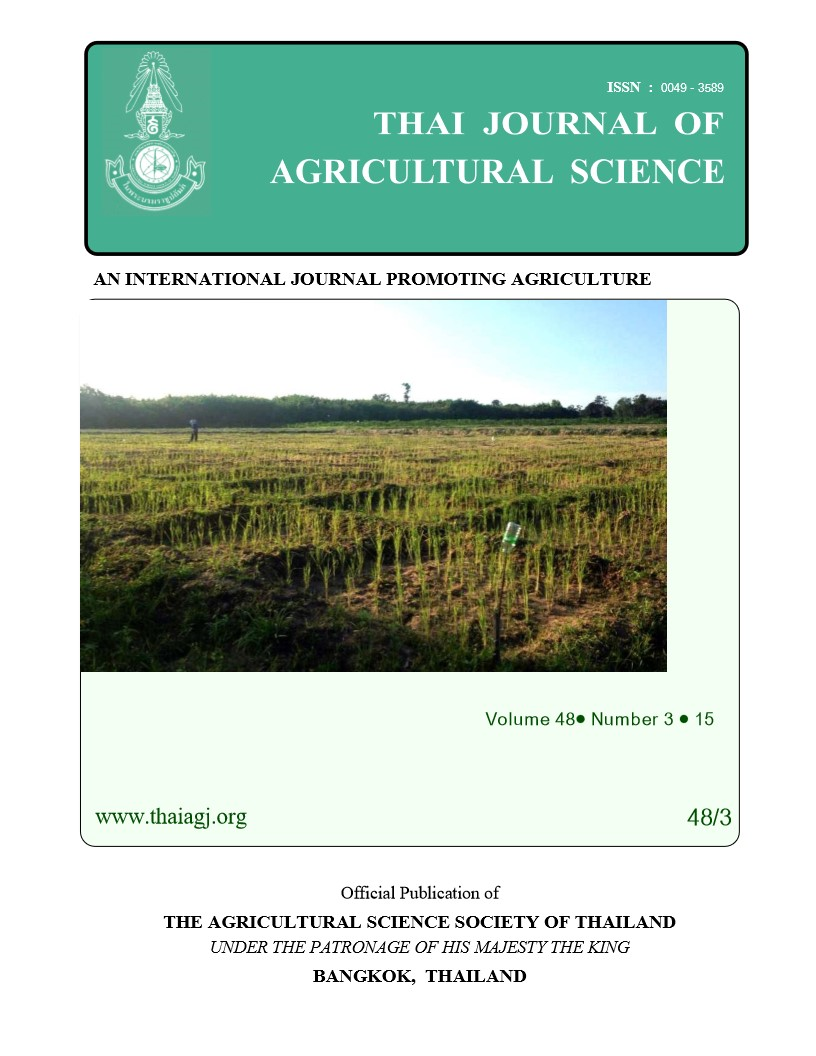Distribution and Concentration of Major and Trace Elements in Paddy Soils and Rice Plant of Khorat Basin, Northeast Thailand
Main Article Content
Abstract
This study determined the distribution and concentration of major and trace elements in paddy soils and rice plants on diverse soil parent materials in Khorat basin, Northeast Thailand. Soils of 100 sites in areas of 16 soil series under paddy cultivation were sampled at three depths (Ap, Ap- 60 and 60-100 cm). The soils were formed on alluvium, residuum derived from sedimentary rock, wash over residuum, wash deposits, and residuum and colluvium of basalt. Above ground parts of rice plants were collected from the site where soil was sampled. Physico-chemical properties of whole soils were determined by standard methods. Heavy metal contents were determined by extraction with aqua regia followed by ICP-OES analysis. Dry ashing of plant material was followed by acid digestion and ICP-OES. Soil texture varies from loamy sand to clay. Values of soil pH in water range from 3.6 to 9.3. Electrical conductivity of soil range from 0.01-3.88 dS m-1. The organic matter content and total N vary from very low to high. Available P and K, CEC, EC and EA range from very low to very high and base saturation percentage from low to high. Most of the paddy soils developed on sedimentary rocks contain much kaolin, traces of illite and quartz. The median concentrations of As, Cd, Cu, Pb, Mo, and Zn are lower than that of normal soils. However, the maximum As concentrations of the soils on alluvium are higher than the critical level of soil quality standard for habitat and agriculture according to Pollution Control Department. The maximum concentrations of Co, Cr, Mn, Ni and V are higher than the critical concentration for plant growth in some paddy soils developed on basalt. Collectively, the results indicate that paddy soils in Khorat basin are without human health risk. The general levels of As, Cr, Cu, Pb and Zn in rice grain are within acceptable levels for human food. The spatial distributions of Co, Cr, Fe, Mn, Ni and V in paddy soils are higher in the southern part of the study area, which is dominated by residuum and colluvium from basalt. The higher As, Pb and Zn concentrations in northern and western parts of the study area reflect the alluvial parent materials. All of elements show a similar spatial distribution with low concentration in the eastern part of the basin. The spatial distribution trend of all metals is similar to that of the clay contents and CEC. Only Co concentration in leaf and grain has significant relationships with total concentration of Al, Ca, Co, Cr, Cu, Fe, Mg, Mn, P and Zn in topsoil. The large variation in chemical composition of the paddy soils in Khorat basin mostly reflects the different nature of their parent materials. Variations in chemical composition due to the contamination by fertilizer application and other agrochemical input are minimal or absent.

